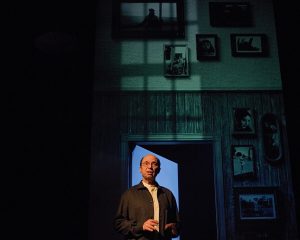As a creative director, visual designer, and artistic director, Marcella Grimaux takes over the stage in a way that makes us dream. Meet a woman who constantly lives on the artistic edge.
She gets to design the look and feel of eagerly-awaited new stage shows by Québec artists; it’s the story of her life. “We’re in a business where we have to put ideas and images to words. It’s not always easy!” says Grimaux.
She grew up in New York City, with her mother as a model and inspiration, before moving to California to study theatre and stage directing at the University of Southern California. Her first acquaintance with the profession was in 2009 with Dominic Champagne, who was then presenting the stage play Paradis perdu (with music by Daniel Bélanger). “As I was only there to shoot the rehearsals, there was no creativity involved, but I was thrilled to be working with him,” she says.

Marie-Mai. Photo by/par Patrick Beaudry
Grimaux began her career at Geodezik in 2010. She started directing in 2018. She now owns her own company, the Noisy Head Studio.
The same question keeps coming up during production meetings: “On what kind of trip are we going to embark? What kind of trip do we want people to experience, what will the visual signature look like?” In the case of pop star Marie-Mai, who had switched record companies to join Spectra Musique with a new sound and a new image, they needed to come up with a visual presentation that was worthy of the artist’s stage comeback. At the Bell Centre, of all places.
For the Elle et moi tour in 2019, Grimaux acted as creative director. “We designed the stage set and the video; the set list was done with her music director, David Laflèche,” says Grimaux. “In what direction could we steer that huge boat? Each song was telling a different story. We visualized the angles of vision in 3D from every Bell Centre seat. We added a staircase, and moving screens, providing us with additional stage entrances and exits. The show’s opening was spectacular. We pre-filmed Marie in the same outfits she would be wearing during the live show to achieve perfect continuity. In one song, “Empire,” she asks, ‘Am I being re-born now?’ That sentence gave us the direction we needed!”
Marcella and her team won the Félix (ADISQ) Awards for Lighting Design and Projections at ADISQ’s 2019 Industry Gala for that show.

Loud. Photo by/par Susan Moss.
People are still talking about Loud’s entrance to the stage for his show at the Bell Centre. The striking use of an airplane cockpit was pure Marcella, in her creative-director role. She co-created the stage sets, and then a short number with Simon Cliche (a.k.a. Loud), besides designing the video content.
“At our first meeting, his manager told me, ‘We’d like to see Simon arriving onstage in a plane,’” she says. “That’s the kind of time when you raise your eyebrows, and write down in your notebook, ‘Arrives in a plane.’
“That was in early February of 2019, and the show was scheduled to open May 31…
“We started designing the stage, but still needed a plane by the middle of March. Building a cockpit from scratch, or even a set, would have been way too expensive. Did you know you can’t buy airplane parts? Each part has a serial number and an owner. It’s illegal, and the reason is, to curb the black market for plane parts.
“A month later, a friend spotted a nearly abandoned aircraft in a Saint-Jean-sur-Richelieu yard! What a lucky break!”

Michel Rivard. Photo by/par Marc-Étienne Mongrain.
Michel Rivard’s Origine de mes espèces show, which won the Félix Aaward for show of the year at the 2019 ADISQ Awards, was a different story. Directed by Claude Poissant, this show (with the fateful moment when Rivard opens the letter revealing his father’s DNA, then blackout!), called for a more sober directional approach.
“How could we portray the memories Michel was talking about in his flashbacks?” asked Grimaux. “We had to scan some 350 photographs from his personal archive to create the video. We were looking for out-of-focus images, looking more like old memories. The golden rule was that the video was only there as an accompaniment. Before, lighting technicians used to insert images themselves because that was their turf. Today, these are two separate operations,” she explains.
Then, there was a memorable solo show with Jean Leloup at Place des Arts in 2016, with a huge fibreglass cranium sitting onstage, complete with light beams. Grimaux was artistic director on that project.
“Jean kept talking about campfires,” she says. “He wanted a campfire feel in Salle Wilfrid-Pelletier – and he’s so all-over-the-place that committing him to something too concrete would have been a mistake. My role was to bring in video universes that we didn’t want to be narrative or continuous: we had to design them in such a way that they would remain flexible, because Jean didn’t have a set list. He might decide to sing “Je joue de la guitare” before “L’amour est sans pitié,” and we had to adapt, we had to be super-flexible. We had four visual universes ready, to help us follow him on whatever musical path he would choose at the last minute. The biggest challenge was a technical one: the size of the background projection screen was nearly as big as an IMAX screen: 50 feet large and 32 feet high!”
The long pause created by the COVID-19 pandemic made it possible for Grimaux to co-direct the video of Patrice Michaud’s song, “La grande évasion,” with her creative partner Daniel Faubert, and then to direct Asteria, a daring new virtual-reality music project that was recently released by the La Maison Fauve and Studio La Fougue.
“At meetings, I’m often the only woman at the table, and I consider myself lucky to be surrounded by men who don’t care one way or the other,” says Grimaux. “But I know of no other studio of this kind in Montréal (Noisy Head Studio) being led by a woman.”